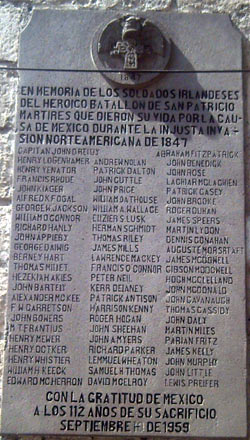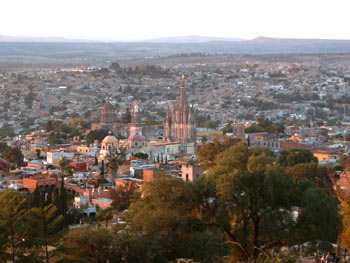Another
Immigrant War, the San Patricios
[3]
|

Plaque in Plaza de San Jacinto, San Ángel
(Francisco Trejo, 2007)
|
Less well
known
than the Alamo story is the story of the European-born
immigrants who fought and died in the Mexican-American war and
in particular, the significant minority who took part on both
sides.
One
Mexican army brigade was called the Saint Patrick's Battalion
(or 'San Patricios'). It was made up of men who began the war
in the US army but defected en masse to the other side,
thereby defending Mexico from the US invasion.
The San
Patricios brigade was made up of recent US immigrants, mainly
professing the Catholic religion. The majority were Irishmen,
recruited from high Texan unemployment by US army recruiters
headed south to fight Polk's war.
The
protection of immigrant rights was a non-issue in those days
predating Homeland Security. Then, as now, rules were
particularly lax in wartime, which meant that many army men
were horribly mistreated to keep them in line. This led to a
slew of army defections to 'volunteer and embrace Mexico's
cause'. Among reasons cited for this traitorous behaviour, was
the conduct of their mainly British Protestant officers, and
the particularly vicious antics of the Texas Rangers when
capturing Mexican towns; desecration of Catholic Church
property, rape and slaughter.
These
opportunist Mexican soldiers of fortune were commanded by John
Riley of Clifden, County Galway. The Battalion of St. Patrick,
800-strong, fought a commendable retreat from US invading
forces as the Americans pushed south to the capital, DF. One
reason cited was the brigade's determination not to be
captured alive. It is even said that the Patrick's battalion
threatened to shoot their Mexican colleagues if they
capitulated to the US forces.
The mainly
Irish-born, English-speaking battalion was given a great deal
of autonomy as to how they fought their former employers;
unfortunately for them they found themselves on the losing
side. As it turned out the Patricios were prudent in avoiding
capture - the US Army had been instructed to make an example
of the Irish Catholic defectors. They meted out face branding
with hot irons (the letter 'D' for Deserter) and most
survivors were summarily hanged. In DF, the US army made a
point of hanging most of the remaining Patricios in the same
Zócalo.
The
valiant Patricios are commemorated annually in Mexico.
Recently Irish dignitaries were invited by former Mexican
President Vicente Fox to share in the 1847-1997 celebrations
in the Zócalo, DF.
The myth of National Independence
It may at
first glance seem like an incongruous list of populations but
modern-day DF and its suburbs were host to the Olmecs, the
Aztecs, the Spanish, the 'Mexican' and for a short time even
the US conquerors. One might suggest that the Spanish
conquerors should be treated as a special case as they ruled
'New Spain' as a European colony, the other regimes being
self-governing, though I would argue otherwise.
What
exactly is the logic of a modern-day self-governing republic?
To what extent is it possible for a modern nation to control
its own destiny, especially in the context of the massive
influence of global transnational corporations and in the
context of regional trade communities such as the European
Union (EU) and the North American Free Trade Agreement
(NAFTA)? These questions are especially pertinent in the case
of Mexico, whose northern neighbour is the largest economic
and military power on the planet.
When
colonial powers cede control to new nations, contacts rarely
come to an abrupt end. Ireland maintained laws that protected
British property rights after 1921. These were written in the
English language as part of predominantly English laws.
Ireland also maintained an economy entirely dependent on
Sterling for many decades. The Mexican revolution was not
dissimilar, although the second Zapatista revolution did alter
some property rights to the benefit of local Mexicans over
foreign landowners, largely as a result of the first Zapatista
rebellion.
Central
Mexico seems like an appropriate place to explore the legacies
of colonial power and to delve into their neocolonial
counterparts.
Dust
of Colony
DF has
some really impressive colonial architecture but the colonial
architectural style is found in many Altiplano Spanish
cities. Particularly beautiful are Zacatecas, Guanajato,
Puebla, Querétaro and, perhaps the most famous of them all,
San Miguel de Allende.
|

San Miguel de Allende,
Guanajuato
(Ruiz, December 2004)
|
San Miguel
de Allende is a city frozen in time by an architectural
heritage law enacted in the nineteen twenties. Her districts
are called 'Colonias' and much of the architecture is from the
more splendid periods of Spanish colonial opulence. San Miguel
is currently undergoing another type of invasion. This began
as a small artistic hippy community. Now in San Miguel, a
thriving real estate industry offers 300-year-old palatial
mansions to a global market. Affluent visitors are tantalised
by monthly bus tours conducted in English, taking curious
tourists to some of the prettier mansions in the city, many of
which are for sale. Most of the buyers are retired people from
the US. In recent decades there have been many Canadian
visitors also, but fluctuating exchange rates affect
participation. Geographical factors such as proximity and the
availability of flights play a significant role in determining
who occupies these beautiful properties, though the buying
power of a nation's currency is also a major factor. There are
more British property owners in San Miguel than Guatemalans.
An Anglo-Irish Colonial Viewpoint
As an
Irish citizen of British descent I have always been somewhat
conflicted about the notion of 'colony'. In the beautiful and
hospitable environs of San Miguel de Allende it is difficult
to recognise a traditional colony. One could argue that
traditional colonies were largely eradicated in the early
1900s with the self-destruction of the Western empires in the
wake of the First World War. In the absence of a foreign army
of occupation, can a colony really exist? If so, how would we
recognise it? What exactly is neo-colonialism?
Hegemony
Defined
Colonisation involved much more than property rights. Any
successful colonial power understands that a precursor to
property ownership is ownership of the mind. Every
expansionist military is accompanied by an expansionist
religion, Spain had its Catholic Jesuits, Dominicans and
others, and the US has evangelical Protestant sects. It is
important to maintain control of property when governments
change. What use is a paper land title, or paper currency for
that matter, if it is no longer negotiable? Religion,
language, and cultural assimilation played a huge role, some
might argue greater than the military role, in maintaining the
colony of 'New Spain' for three hundred years.
Founding Mexico
Modern
Mexico is a sovereign nation state born in the traditional
manner of various anti-colonial rebellions, and
constitutionally governed by the Mexicans as a Federal state.
Or so it seems. As a nation state, the founders of modern
Mexico learned the value of property the hard way and took
some measures to protect their land from becoming the property
of external powers. Non-Mexican citizens are not allowed to
buy property in Mexico but they can buy and sell a ninety-nine
year lease and, recently, former Mexican President Fox of the
neoliberal PAN party made it easier for foreign citizens to
apply for Mexican citizenship.
There are
many parallels to this form of protectionism. Take London for
example. The Duke of Westminster owns some of the most
lucrative land leases in the City of London; in fact it is
more precise to say the Duke of Westminster owns the City of
London. You cannot buy land in parts of central London because
those lands are not for sale. Why sell when you can lease? By
this means, the Duke of Westminster has income in perpetuity,
and the land will always belong to the Crown. The title passes
down through the British Royal family to the next Duke.
Trust in Money
On the
back of a US dollar note, one reads 'In God We Trust'. Since
currencies broke with the gold standard under US president
Nixon, their values float. The 'Gods' of international finance
determine the relative value of the pieces of paper we carry
in our wallets. Whether I get 10.9 or 11.2 Mexican pesos to the US
dollar, or 13 or 14 to the euro, is a decision made at the
currency markets of New York, London and Zurich, and to a
lesser extent in DF.
|



